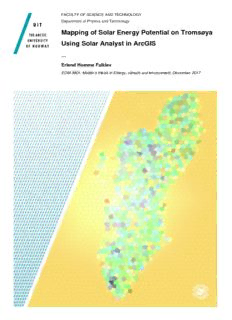Table Of ContentFACULTY OF SCIENCE AND TECHNOLOGY
Department of Physics and Technology
Mapping of Solar Energy Potential on Tromsøya
Using Solar Analyst in ArcGIS
—
Erlend Homme Falklev
EOM-3901: Master’s thesis in Energy, climate and environment, December 2017
i
Front page created by Trond-Ola Hågbo.
The truth is: the natural world is changing.
And we are totally dependent on that world.
It provides our food, water and air.
It is the most precious thing we have and we need to defend it.
Sir David Attenborough
Abstract
The price of solar energy is declining, and will continue to decline the coming years. This will
make it easier for households and companies to utilize solar energy. Because of this, several
solar map projects have been established in the recent years. The aim of this study is to create
a solar map of Tromsøya, and thoroughly explain the process in doing so. The process chosen
for making the map is the same as used by Oslo Solar Map, made by Oslo Housing and Building
Department. This involves the ArcGIS based package Solar Analyst Tools, which includes the
tools Solar Radiation Graphics, Points Solar Radiation and Area Solar Radiation. These tools
are created for modeling solar radiation at landscape scales. Solar Analyst require input of
diffusion fraction and transmittivity value, which have an important effect on the results. These
values are calculated by combining weather station measurements with calculation in Solar
Analyst. One of the crucial issues in the creation of the solar map with this process is excessive
computing times. Reducing computing time is investigated with the use of sectoring and
investigating how the tools operate and utilizes computing power.
i
ii
Acknowledgements
I have always wanted to do my best to fight climate change. I hope this thesis can provide a
small part of the solution, as well as giving me a path to a meaningful job, in which I can
continue to work towards a safe planet for future generations.
I am deeply indebted to my fellow students for giving me a family 2000 kilometers from home.
Thank you for five awesome years.
I specifically want to thank my supervisor Clara Good for great advice and support through the
process of writing this thesis. I also want to thank Rolf Andersen and Espen Tangen at the
Section for Digital Research Services for invaluable input and inspiration in reducing
computing time for solar maps. Stefanie Adamou from Oslo Housing and Building Department
have been available throughout the last 3 months, and provided necessary and valuable
information for this thesis. In addition, Marta Kováčová deserves recognition for motivation
and encouragement in the last month of writing, along with my brother Anders Homme for
proofreading this thesis.
Lastly, I want to express gratitude to my family. You are the most important part of my life.
iii
iv
Table of Contents
Abstract ................................................................................................................................................................... i
Acknowledgements............................................................................................................................................... iii
Table of Contents .................................................................................................................................................. v
List of Abbreviations .......................................................................................................................................... vii
1 Introduction .................................................................................................................................................. 1
1.1 Objective ................................................................................................................................................ 1
1.2 Existing Solar Map Projects .................................................................................................................. 2
1.2.1 Oslo Solar Map ................................................................................................................................. 2
1.2.2 Solkart.no .......................................................................................................................................... 2
1.2.3 Stockholm Solar Map ........................................................................................................................ 3
1.2.4 Google Project Sunroof ..................................................................................................................... 3
1.3 Study Area ............................................................................................................................................. 3
1.4 Structure of the Thesis ........................................................................................................................... 4
2 Theory ........................................................................................................................................................... 5
2.1 Solar Energy .......................................................................................................................................... 5
2.1.1 Properties of Solar Radiation ............................................................................................................ 5
2.1.2 Direct, Diffuse and Global Radiation ................................................................................................ 6
2.1.3 Solar Radiation in Norway ................................................................................................................ 7
2.2 Photovoltaics ......................................................................................................................................... 8
2.2.1 Photovoltaics in Arctic conditions .................................................................................................. 10
2.2.1.1 Efficiency Temperature Dependence ..................................................................................... 10
2.2.1.2 Snow ....................................................................................................................................... 10
2.2.1.3 Tracking Systems ................................................................................................................... 11
2.3 Geographic Information System .......................................................................................................... 13
2.3.1 Data input in GIS ............................................................................................................................ 13
2.3.1.1 Digital Elevation Model ......................................................................................................... 15
3 Method ........................................................................................................................................................ 19
3.1 ArcGIS ................................................................................................................................................. 19
3.1.1 Solar Analyst ................................................................................................................................... 19
3.1.1.1 Viewshed, Sunmap and Skymap ............................................................................................ 20
3.1.1.2 Calculation of Direct Solar Radiation..................................................................................... 28
3.1.1.3 Calculation of Diffuse Solar Radiation ................................................................................... 29
v
3.1.1.4 Calculation of Global Solar Radiation .................................................................................... 30
3.2 Data Processing .................................................................................................................................. 31
3.3 Calculation of Diffuse Fraction and Transmittivity............................................................................. 34
3.3.1 Holt Weather Station ....................................................................................................................... 34
3.3.1.1 Output Data ............................................................................................................................ 35
3.3.2 Calculation with PSR and Weather Data......................................................................................... 39
3.3.2.1 Points Solar Radiation Tool .................................................................................................... 40
3.3.2.2 Final Calculation of D and T .................................................................................................. 45
3.4 Solar Radiation Modelling .................................................................................................................. 46
3.4.1 Data Collection ................................................................................................................................ 46
3.4.2 Data Processing and Sectoring ........................................................................................................ 46
3.4.3 Creation of the Solar Map ............................................................................................................... 50
4 Results and Discussion ............................................................................................................................... 53
4.1 Final Solar Map .................................................................................................................................. 53
4.1.1 Monthly Solar Maps ........................................................................................................................ 55
4.1.2 Global Radiation Output Validity ................................................................................................... 57
4.2 Sensitivity Analysis .............................................................................................................................. 58
4.2.1 Consequences of Sectoring ............................................................................................................. 58
4.2.1.1 Cell Overlap ........................................................................................................................... 59
4.2.2 Diffusion Fraction and Transmittivity ............................................................................................. 62
4.3 Computing Time .................................................................................................................................. 65
5 Conclusion ................................................................................................................................................... 67
5.1 Conclusion ........................................................................................................................................... 67
5.2 Further Work ....................................................................................................................................... 67
5.2.1 Solar Energy Output ........................................................................................................................ 67
5.2.2 Map Extension to Tromsø Municipality.......................................................................................... 68
5.2.3 Include Buildings and Facades ........................................................................................................ 68
6 Bibliography ............................................................................................................................................... 69
7 Appendix ..................................................................................................................................................... 73
7.1 Values for Diffusion Fraction and Transmittivity ................................................................................ 73
7.2 Solar Map Each Month........................................................................................................................ 75
vi
Description:The price of solar energy is declining, and will continue to decline the coming years. This will (ESRI, About ArcGIS 2017). This thesis will involve the use of the ArcGIS Desktop version 10.5, and Esri's new ArcGIS. Pro software. They are main desktop versions that can use a variety of tools to ex

